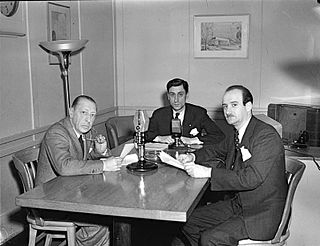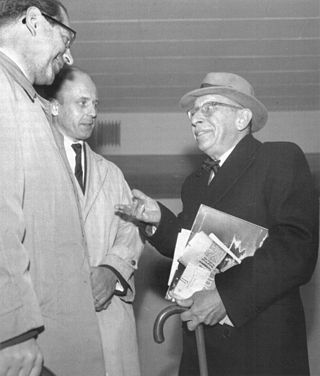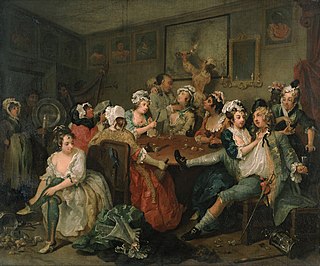Related Research Articles

Igor Fyodorovich Stravinsky was a Russian composer and conductor with French citizenship and United States citizenship. He is widely considered one of the most important and influential composers of the 20th century and a pivotal figure in modernist music.

A cantata is a vocal composition with an instrumental accompaniment, typically in several movements, often involving a choir.

The Serenade for Tenor, Horn and Strings, Op. 31, is a song cycle written in 1943 by Benjamin Britten for tenor, solo horn and a string orchestra. Composed during the Second World War at the request of the horn player Dennis Brain, it is a setting of a selection of six poems by English poets on the subject of night, including both its calm and its sinister aspects. The poets Britten chose to set for the Serenade range from an anonymous 15th-century writer to poets from the 17th, 18th and 19th centuries.

The Rake's Progress is an English-language opera from 1951 in three acts and an epilogue by Igor Stravinsky. The libretto, written by W. H. Auden and Chester Kallman, is based loosely on the eight paintings and engravings A Rake's Progress (1733–1735) of William Hogarth, which Stravinsky had seen on 2 May 1947, in a Chicago exhibition.

Neoclassicism in music was a twentieth-century trend, particularly current in the interwar period, in which composers sought to return to aesthetic precepts associated with the broadly defined concept of "classicism", namely order, balance, clarity, economy, and emotional restraint. As such, neoclassicism was a reaction against the unrestrained emotionalism and perceived formlessness of late Romanticism, as well as a "call to order" after the experimental ferment of the first two decades of the twentieth century. The neoclassical impulse found its expression in such features as the use of pared-down performing forces, an emphasis on rhythm and on contrapuntal texture, an updated or expanded tonal harmony, and a concentration on absolute music as opposed to Romantic program music.
The "Lyke-Wake Dirge" is a traditional English folk song and dirge listed as number 8194 in the Roud Folk Song Index. The song tells of the soul's travel, and the hazards it faces, on its way from earth to purgatory, reminding the mourners to practise charity during lifetime. Though it is from the Christian era and features references to Christianity, much of the symbolism is thought to be of pre-Christian origin.

The Symphony of Psalms is a choral symphony in three movements composed by Igor Stravinsky in 1930 during his neoclassical period. The work was commissioned by Serge Koussevitzky to celebrate the 50th anniversary of the Boston Symphony Orchestra. The symphony derives its name from the use of Psalm texts in the choral parts.

The Symphony in Three Movements is a work by Russian expatriate composer Igor Stravinsky. Stravinsky wrote the symphony from 1942–45 on commission by the Philharmonic Symphony Society of New York. It was premièred by the New York Philharmonic Orchestra under Stravinsky on January 24, 1946.

Iša František Krejčí was a Czech neoclassicist composer, conductor and dramaturge.

Canticum Sacrum ad Honorem Sancti Marci Nominis is a 17-minute choral-orchestral piece composed in 1955 by Igor Stravinsky (1882–1971) in tribute "To the City of Venice, in praise of its Patron Saint, the Blessed Mark, Apostle." The piece is compact and stylistically varied, ranging from established neoclassical modes to experimental new techniques. The second movement, "Surge, Aquilo", represents Stravinsky's first movement based entirely on a tone row.

Igor Stravinsky composed his Mass between 1944 and 1948. This 19-minute setting of the Roman Catholic Mass exhibits the austere, Neoclassic, anti-Romantic aesthetic that characterizes his work from about 1923 to 1951. The Mass also represents one of only a handful of extant pieces by Stravinsky that was not commissioned. Part of the motivation behind its composition has been cited by Robert Craft and others as the product of a spiritual necessity, as Stravinsky intended the work to be used functionally.
Elegy for J.F.K. is a piece of vocal music composed by the Russian-born composer Igor Stravinsky in 1964, commemorating the assassination of U.S. President John F. Kennedy.
Colin Tilney is a harpsichordist, fortepianist and teacher.
Deborah York, born 1964 in Sheffield, Yorkshire, England, is a classical soprano in concert and opera, and a teacher and conductor. She has British and German nationalities and has been living in Berlin since 1996.

Johann Sebastian Bach composed the church cantata Die Elenden sollen essen, BWV 75, for the first Sunday after Trinity. He debuted it in Leipzig on 30 May 1723, assuming the position of Thomaskantor. The complex work is in two parts, each consisting of seven movements, and marks the beginning of his first annual cycle of cantatas.
The Septet for clarinet, bassoon, horn, piano, violin, viola and cello is a Chamber music composition by Igor Stravinsky. It was composed between July 1952 and February 1953, and the first performance took place at Dumbarton Oaks in Washington, D.C., on 23 January 1954. The score is dedicated to the Dumbarton Oaks Research Library and Collection. It consists of three movements, the first lacking a title, and the last lacking a number in the score. The work is influenced by twelve-tone technique, especially by the Wind Quintet, Op. 26, and the Suite for septet, Op. 29, composed by Arnold Schoenberg.

A Sermon, a Narrative and a Prayer is a cantata for alto and tenor singers, a narrator, chorus, and orchestra by Igor Stravinsky, composed in 1960–61. It belongs to the composer’s serial period, and lasts a little over a quarter of an hour in performance.

Tavern Scene or The Orgy is a work by William Hogarth from 1735, the third picture from the series A Rake's Progress.
References
- ↑ White, Eric Walter (1979). Stravinsky: The Composer and His Works (2nd ed.). Berkeley and Los Angeles: The University of California Press. pp. 468–9. ISBN 0-520-03985-8.
- ↑ Auden, W.H.; Pearson, Norman Holmes, eds. (1950). Poets of the English Language. 5 vols. New York City: Viking. 1:426–31.
- ↑ Falby, Vern Clifford. 1987. "Music in and out of Words: Music, Language, and Stravinsky's Vocal Works of 1948–54. Ph.D. diss. College Park: University of Maryland. p. 319.